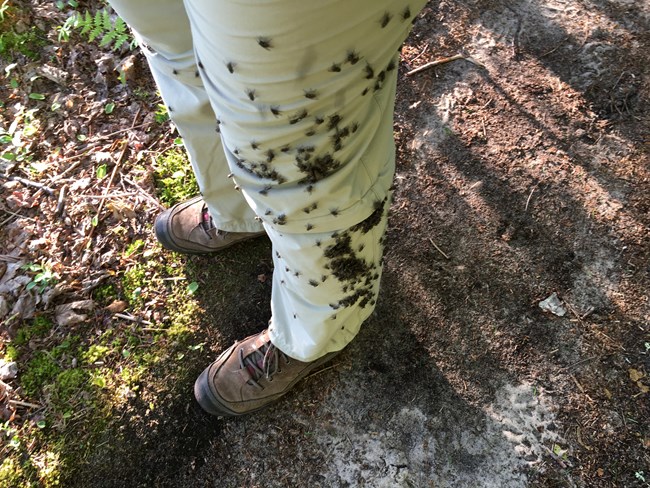
NPS photo What's Biting You?An outdoor adventure at Pictured Rocks National Lakeshore is an exhilarating experience but at certain times of the year visitors can be negatively impacted by some of the park's smallest inhabitants: biting insects. Black fliesBlack flies are very small, gnat-like insects that often gather in swarms. They lay eggs in running water and their larvae attach themselves to rocks. Black flies tend to be present in the park in spring until about June but can also appear during cool fall weather. Bites from the females cause painful itching and swelling that can last for several days or even weeks. Head nets are recommended during black fly season. Luckily, North American black flies do not transmit disease to humans. Stable fliesThe stable fly is the main biting fly at Pictured Rocks beaches and along the shore in mid to late summer, especially on warm humid days with a south wind. The stable fly looks like a small house fly, but it can inflict a painful bite, usually on its victim's legs and ankles. Both the male and female bite, but they also feed on pollen. Unlike the other biting insects, the larvae of the stable fly are terrestrial, and live in and eat decaying vegetation that washes up along the shore. Stable flies are not known to transmit disease in humans, but are annoying enough to drive people away from beaches when they are numerous. Deer flies & Horse fliesDeer flies and horse flies appear by mid-summer, generally when the mosquitoes and black flies decrease in number. Deer flies have brightly colored eyes and patterned wings, and come in a variety of different types. The much larger horse flies are more drab brown or black, sometimes with light spots, and clear wings. Females of both deer and horse flies fly in noisy, fast circles around their chosen victim, and can inflict painful bites. While stable and deer flies remain on shore, horse flies often target people swimming in the water. No-See-UmsAlso called Punkies or Biting Midges, No-See-Ums resemble miniature, short-legged mosquitoes, and are usually less than 3 millimeters long. Only females of a few species bite humans. The majority bite other insects or eat nectar. No-See-Ums that bite humans are less common than other biting insects in Pictured Rocks. TicksTicks are not insects, but tiny arachnids (related to spiders and mites) that also bite humans. Ticks are present in the park although they are not as numerous here as in other parts of the country. They are found in a variety of habitats, usually in tall grass or in dense shrubs where they wait for a four-legged or two-legged (human) mammal to pass by. Ticks are known to transit Lyme disease and other serious diseases so it's important to take precautions to avoid them. Stay on trails and check your clothing and body after every hike. BE SAFE!Since biting insects and ticks are not merely annoying but might transmit disease or cause other medical problems, it is always best to play it safe and avoid being bitten. Use protective clothing and insect repellent. Check yourself for ticks. Carry an allergy medicine or anti-histamine in case of an allergic reaction to a bite.
.
|
Last updated: August 26, 2024
